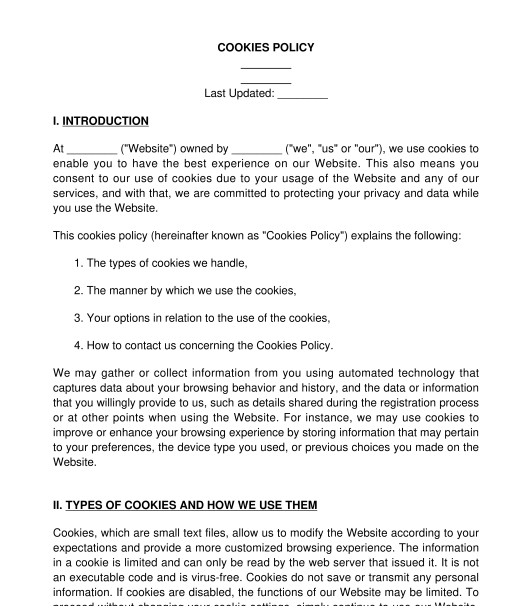 10/31/2025
10/31/2025

Answer a few questions and your document is created automatically.

Your document is ready! You will receive it in Word and PDF formats. You will be able to modify it.

 10/31/2025
10/31/2025
 Word and PDF
Word and PDF
 3 to 4 pages
3 to 4 pages
A Cookies Policy can be used by any person or organization in the Philippines that owns a website to lay down the manner by which the collection or handling of cookies is done.
Cookies are certain data or pieces of information pertaining to the users of the website. Websites that render a service or sell a product generally use cookies to be able to know and learn from the behavior of the users and improve the user's experience on the website. If cookies are being handled and used by the website, the owner of the website should provide a cookies policy to inform the users of their rights and to prevent unauthorized processing of user information. The common types of cookies are as follows:
Analytics Cookies. These cookies are used to analyze user behavior and trend patterns to customize user experience.
Session Cookies. These are temporary cookies that store user information for one browsing session.
Persistent Cookies. These cookies allow user information to be stored longer than one session of browsing the website.
Profiling Cookies. These are cookies that collect information about the users for advertising or marketing.
Third-party cookies. generated and placed on the user's device by other websites and services.
The users have the right to know how their data including cookies are processed and used, thus, it is important to inform them of the purpose of the use of the cookies as well as the length of time they remain on the website after which the cookies should be deleted. The time the cookies remain on the website (also called the "retention period") must not be longer than is necessary for the intended use of the cookies.
The cookies policy is considered an agreement by which users can provide their consent in a certain manner usually through a pop-up and a check box where the user is asked if they allow the use of cookies. A cookies policy, as well as a privacy policy as well as the terms and conditions, should be shown on the website to ensure the protection of the informational rights of the users and allow the users to intelligently give their consent as to how their information will be handled by the website.
The owner of the website should complete the following information:
After providing the above details the website owner can now post the cookies policy on their website which the users can easily access and read. The link to the cookies policy is usually placed on the footer or at the end of the web pages of the website alongside the links to the privacy policy and terms and conditions of the website. If there will be changes in the cookie policy, it must be updated and posted in the manner mentioned above as soon as practicable.
This document is governed by the Provisions of R.A. 10173 or the Data Privacy Act of 2012 and its rules and regulations.
You fill out a form. The document is created before your eyes as you respond to the questions.
At the end, you receive it in Word and PDF formats. You can modify it and reuse it.
Cookies Policy - sample template online - Word and PDF
Country: Philippines